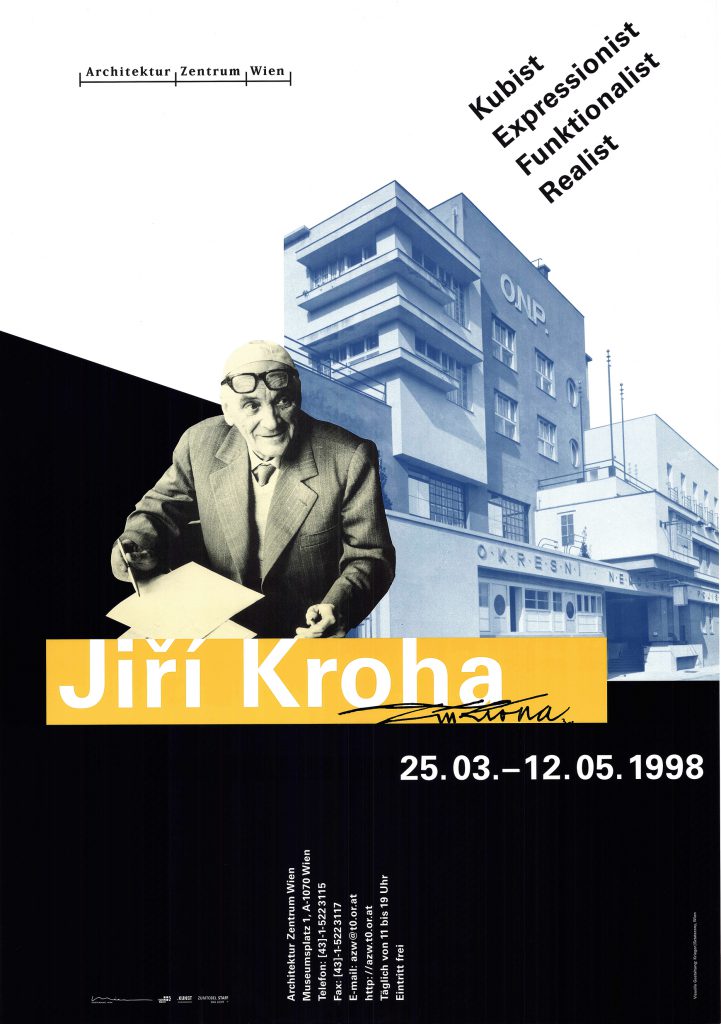Exhibition
JIRI KROHA
Cubist, Expressionist, Functionist, Realist

Exhibition poster: JIRI KROHA
© Architekturzentrum Wien, graphic design: Krieger|Sztatecsny, Büro für visuelle Gestaltung
opening: Tuesday, March 24, 1998, 7.00 pm
Jirí Kroha (1893-1974) belongs to the second generation of Czech modernists. The first phase of his comprehensive work as an architect, painter and theorist is influenced by Czech cubism and expressionism. During the 20`s, modern architecture emerged as a symbol for the newly established Czech Republic . Several buildings by Jirí Kroha are formally as well as in their contains obliged to the demands created by the ideas of Neues Bauen. Kroha`s intellectual biography concentrates during the 30`s on housing, which he understood as a ” three -dimensional realisation of the process of living”.
The exhibition will trace certain ideas and phenomenas in the work of Jirí Kroha through seven time periods from 1915 to 1951.
Opening:
Dietmar Steiner
Director Architekturzentrum Wien
Monika Platzer, Klaus Spechtenhauser
Curators of the exhibition
François Burkhardt
Director of “Domus”
Dr. Jaroslav Mlcak
Cultural Attaché of the Czech Republic
Press Release
Jirí Kroha (1893-1974) belongs to the second generation of Czech modernists along with Bohuslav Fuchs, Karel Teige, und Jaromír Krejcar. However, with the exception of Bohuslav Fuchs and Karel Teige, the names of the architects are not widely known.
In Prague, before World War I, Czech cubism expresses itself in a manifest-like manner. The formal and substantial aspects of this movement in art play a decisive role in Kroha’s life. The principle of this new type of architecture lies in the dynamization of passive material. His utopian drafts climax in Kroha’s entry for the competition of the Pardubice Crematorium in 1919-1920.
At almost the same time he begins carrying out formal experiments, the “primary plans”. These drafts are designed according to purist formal principles and appear as the opposite pole of the preceding as well as contemporary expressionist-cubist architectural sketches. This contradiction is eliminated in the provincial commercial school in Mlada Boleslaw 1922-1927, the first of his projects to be actually carried out. In combination with terraced building units that penetrate each other, the seemingly dormant volume is set into motion. Several buildings with an formal avant-garde vocabulary follow, however not in Prague’s cultural and social center but in Mlada Boleslav, the headquarters of the Skoda car plant in northern Bohemia. The organisation of the Comprehensive Exhibition in Northern Bohemia 1926-1927 marks the end of his busy construction activities in this region and presents the first manifestations of Kroha’s next phase. In 1925 he is appointed professor of architecture at the Czech Technical University in Brno.
Between 1928 and 1931 he builds the Villa Kroha in Brno according to the ideas of the Neues Bauen. For Kroha this family house is an experiment, whose aim is to differentiate spatially between the biological, economic, and cultural needs of the inhabitants. He carries out theoretical studies such as the Sociological Fragment of Housing 1930-1932. It comprises analyses of housing standards and family structures, shows area and spatial standards, and discusses the utilization variability of apartments. Kroha’s position lies somewhere between the individualistic-artistic and the scientific-programmatic approach. The societization of architecture has negative consequences for Kroha’s life. He is suspended from his position as professor in Brno from 1935 to 1936 because of leftist political activities. He is, however, rehabilitated in 1937.
After World War II, Kroha continues his theoretical studies on the subject matter under different conditions. Under Klement Gottwald he is awarded the title of National Artist in 1948.
The exhibition will trace certain phenomena in the work of Kroha in seven time sections. With the exception of some exhibits at other larger theme exhibitions, Jirí Kroha has not been exhibited outside the Czech Republic. The exhibition will be accompanied by a catalogue, which will introduce the German-speaking public to Kroha’s works.
Biographie / Worklist
1893
Jiri Kroha is born on June 5 in Prague.
1911-1916
Studied architecture at the Technical University in Prague (Professors Antonín Balsanek, Josef Fanta, Jan Koula, Rudolf Krizenecky). Formal experiments (“Primary Plans”), several architectural studies under the influence of cubism and expressionism.
1918
Displayed sculptural and architectural work at the member exhibition of the SVU, became a member. Designed the Montmartre Bar in Prague. Began to work intensively with theater, designed stage sets, directed, and published in theatrical magazines.
1922-1927
Planned and built primarily in Mlada Boleslav and surroundings. The major projects carried out include the Public Officer Villas in Kosmonosy (1920-1925), the Provincial Commercial School (1922-1927), and the Social Welfare Institute (1924-1925) in Mlada Boleslav as well as the Comprehensive Exhibition in Northern Bohemia (1926-1927) also in Mlada Boleslav.
1925
Appointed professor for architecture at the Czech Technical University in Brno (-1953). Kroha worked as a painter, scenograph, and director.
1927
Established the magazine Horizont as a discussion forum for contemporary tendencies in culture, especially architecture.
1928
Projects for the Exhibition of contemporary culture of the CSR in Brno. House for the exhibition The new house [Novy dum] (1927-1928).
1928-1931
Designs and builds his own house (Villa Kroha) in Brno. Designed a house for the Baba Housing Project in Prague.
1930
Study visit to the USSR. Founding member of the Architecture Section of the Left Front [Leva fronta].
1931
Participated at the competition for apartment houses of the communist co-operative Vaela in Prague.
1933
Presentation of the ‘Sociological Fragment of Housing’ [Sociologicky fragment bydleni] (arranged in 1930-1932) at the Exhibition on Building and Housing in Brno. Further studies on housing issues follow. Chairman of the newly-founded Federation of Socialist Architects.
1934-1937
Suspended from his position as professor in Brno.
1935-1936
Villa Patocka in Brno.
1939-1940
Imprisoned (Brno-Spilberk, Dachau, Buchenwald).
1945
After World War II, Kroha concentrated mainly on painting and organizing exhibitions.
1947-1948
Chief designer for the Slavic Agricultural Exhibition in Prague.
1948
Appointed National Artist.
1974
Jiri Kroha dies on June 7 in Brno.
